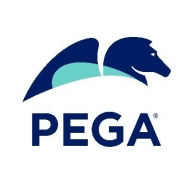

Pega Platform and Camunda compete in the Business Process Management (BPM) category. While Pega offers a comprehensive suite for enterprise-level applications, Camunda provides a robust open-source alternative. Pega has the upper hand in features and enterprise suitability, but Camunda excels in cost-effectiveness and developer-friendliness.
Features: Pega Platform includes case management, rapid implementation, and robust multi-channel capabilities, making it suitable for complex processes. It offers an advanced low-code environment and outstanding integration capabilities. Camunda stands out with BPMN standard support, modular architecture, and microservices integration. It provides a lightweight and flexible environment tailored for developers, although it lacks some pre-built features.
Room for Improvement: Pega's pricing model and cloud presence pose challenges, especially for small businesses, alongside complex upgrades and high costs of implementation. Enhancements in low-code user experience and integration could broaden its appeal. Camunda, being open-source, requires more technical expertise and lacks extensive pre-built solutions. Improved user interface and support for various languages would enhance its usability further.
Ease of Deployment and Customer Service: Pega supports diverse deployment options such as on-premises, public cloud, and hybrid models but receives mixed customer service reviews due to delays and complexity. Camunda's deployment is praised for simplicity, particularly within open-source communities, although it falls short on enterprise-level support and documentation.
Pricing and ROI: Pega is often seen as expensive, which may dissuade smaller enterprises, yet it promises substantial ROI for larger organizations via process automation. Camunda’s open-source nature offers a budget-friendly alternative, appealing to organizations with technical expertise. Nevertheless, its paid version could increase costs as processes scale, balancing between cost and capabilities for tailored needs.
AWS provides the best support, followed by Microsoft, and then Google.
They provide better support for the enterprise edition.
The technical support from Pega is very low, rating a one or two out of ten.
I never needed support from the platform standpoint, but if additional features are required, we have regular meetings with the product team for feedback.
Pega's technical support team is very helpful.
Camunda offers a high level of scalability, especially when using its SaaS model, which manages and scales implementations automatically.
ECS and Fargate make horizontal scalability very easy.
Currently, big banking providers and insurance providers, even the members for healthcare payers, are using more than millions of operations on a daily or weekly basis.
There haven't been any significant outages in my experience with Camunda.
More open documentation would be beneficial to understand the deployment process better and facilitate easier setup.
There is an issue where, in some situations, I need to scale up by observing both CPU and memory usage of containers, yet under the current options available at Amazon, this is not possible.
For customer interactions, while the Pega Platform's AI-based decisioning and predictive analytics are great, the Process AI is not very popular yet, as it works on process data rather than customer data.
Pega introduced Constellation, which allows a user to build a more engaging visual experience.
My learning curve in robotics has been challenging.
For some services, such as hosting databases, Google is really expensive.
There is a licensing cost for using the SaaS model and Enterprise edition of Camunda.
From a licensing perspective, it is higher than the competition.
The pricing is expensive, and this is an issue.
Pega is priced higher than open-source options like Flowable but is suitable for large-scale industries like banking and insurance.
ECS also allows for horizontal scalability with thresholds that can be configured for CPU or memory.
The biggest difference between Camunda and Bonita might be that Camunda is simpler and more flexible for setting.
Pega Platform is excellent for enterprise-level solutions with integrations to entire systems, including case management, service orchestration, CRM, decision-making capabilities, digital process automation, and AI-driven functionalities.
Management capabilities such as dashboards.
| Product | Market Share (%) |
|---|---|
| Camunda | 16.0% |
| Pega Platform | 5.2% |
| Other | 78.8% |


| Company Size | Count |
|---|---|
| Small Business | 41 |
| Midsize Enterprise | 15 |
| Large Enterprise | 29 |
| Company Size | Count |
|---|---|
| Small Business | 9 |
| Midsize Enterprise | 15 |
| Large Enterprise | 68 |
Camunda revolutionizes process orchestration by enabling seamless automation and integration with AI, human tasks, and existing systems while ensuring security and governance.
Built for collaboration between business and IT, Camunda empowers organizations to manage complexity, boost efficiency, and maintain competitive advantage. With a clientele of over 700 top organizations like Atlassian, ING, and Vodafone, Camunda is a trusted partner in designing, orchestrating, automating, and refining critical business processes to accelerate digital transformation. Its open-source nature, ease of use, and REST API integration make it a versatile choice for various needs.
What are Camunda's key features?In banking, Camunda automates processes and manages transactions, while in telecommunications, it optimizes service orders. Governmental and public sectors benefit from workflow automation. Organizations often use either the enterprise edition or the open-source version to create APIs and manage business rules effectively.
Pega Platform facilitates business process management, case management, and workflow automation for industries like banking, insurance, and healthcare. It supports digital transformation and customer service enhancements with its low-code capabilities and seamless integrations.
Pega Platform enables users to create efficient systems for case management, financial operations, and digital transformations. It provides tools for client onboarding, quoting, claims processing, customer experience improvements, and content management. Pega's low-code approach allows for the automation of complex processes, making it suitable for enterprises looking for adaptability and rapid deployment. While it offers strong real-time analytics and decision automation, users acknowledge challenges in user interface, integration, and performance aspects. High costs and a learning curve need attention, and enhancements in AI features and cloud services are desired.
What are the key features of Pega Platform?In banking, Pega Platform automates loan processing, accelerates customer onboarding, and manages compliance. Insurance companies benefit from streamlined claims processing and policy management. Healthcare sectors use the platform for patient engagement and care coordination, enabling organizations to adapt quickly to changing industry requirements.
We monitor all Business Process Management (BPM) reviews to prevent fraudulent reviews and keep review quality high. We do not post reviews by company employees or direct competitors. We validate each review for authenticity via cross-reference with LinkedIn, and personal follow-up with the reviewer when necessary.